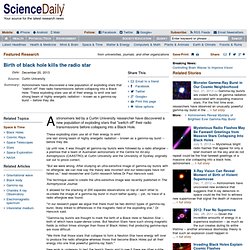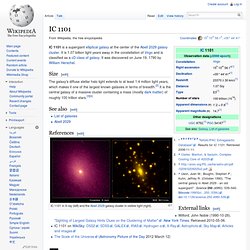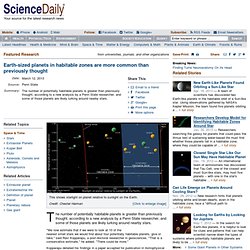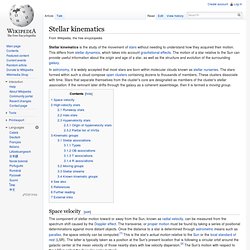

NASA simulation shows the birth of a black hole as two neutron stars collide. A star undergoes incredible changes when it exhausts its nuclear fuel.

The exact nature of those changes depends on how massive the star is, but it usually involves a supernova explosion. The stellar remnant can take many forms, but one of the most fascinating is the neutron star. These super-dense objects can have the mass of 500,000 Earths in a sphere just 12 miles across. NASA’s Goddard Space Flight Center has brought to bear incredible computing power to simulate the collision of two neutron stars to produce one of the few celestial objects more awe-inspiring than a neutron star — a black hole.
Why Are There No Purple or Green Stars. Although you can spot many colors of stars in the night sky, purple and green stars aren't seen because of the way humans perceive visible light.

Stars are a multicolored bunch. Birth of black hole kills the radio star. Astronomers led by a Curtin University researcher have discovered a new population of exploding stars that "switch off" their radio transmissions before collapsing into a Black Hole.

These exploding stars use all of their energy to emit one last strong beam of highly energetic radiation -- known as a gamma-ray burst -- before they die. Up until now, it was thought all gamma-ray bursts were followed by a radio afterglow -- a premise that a team of Australian astronomers of the Centre for All-sky Astrophysics (CAASTRO) at Curtin University and the University of Sydney originally set out to prove correct.
"But we were wrong. After studying an ultra-sensitive image of gamma-ray bursts with no afterglow, we can now say the theory was incorrect and our telescopes have not failed us," lead researcher and Curtin research fellow Dr Paul Hancock said. The technique used to create the ultra-sensitive image was recently published in The Astrophysical Journal. NASA's Chandra Observatory catches giant black hole rejecting material. Astronomers using NASA's Chandra X-ray Observatory have taken a major step in explaining why material around the giant black hole at the center of the Milky Way Galaxy is extraordinarily faint in X-rays.

This discovery holds important implications for understanding black holes. IC 1101. Size[edit] The galaxy's diffuse stellar halo light extends to at least 1.4 million light years, which makes it one of the largest known galaxies in terms of breadth.[2] It is the central galaxy of a massive cluster containing a mass (mostly dark matter) of roughly 100 trillion stars.[3][4] IC 1101 in X-ray (left) and the Abell 2029 galaxy cluster in visible light (right).

See also[edit] References[edit] External links[edit] Coordinates: 15h 10m 56.1s, +05° 44′ 41″ A magnetar at the heart of our Milky Way. Giant black hole could upset galaxy evolution models. Precisely measuring velocity of supernova shockwave. A research team led by Tomoro Sashida and Tomoharu Oka (Keio University) has succeeded in precisely measuring the expansion velocity of a shockwave of the supernova remnant W44.

The remnant is located in the constellation of Aquila, approximately 10,000 light-years away from our solar system. The team observed the high-temperature and high-density molecular gas in the millimeter/submillimeter wave ranges. The analysis shows that the expansion velocity of the W44 shockwave is 12.9±0.2 km/sec. In addition, it became clear that the supernova explosion released kinetic energy of (1-3)×1050 erg into the interstellar medium. The energy emitted from the Sun is approximately 3.6 × 1033 ergs/sec. Mysterious objects at the edge of the electromagnetic spectrum. The human eye is crucial to astronomy.

Without the ability to see, the luminous universe of stars, planets and galaxies would be closed to us, unknown forever. Nevertheless, astronomers cannot shake their fascination with the invisible. Outside the realm of human vision is an entire electromagnetic spectrum of wonders. Each type of light--from radio waves to gamma-rays--reveals something unique about the universe. Some wavelengths are best for studying black holes; others reveal newborn stars and planets; while others illuminate the earliest years of cosmic history. NASA has many telescopes "working the wavelengths" up and down the electromagnetic spectrum. "Fermi is picking up crazy-energetic photons," says Dave Thompson, an astrophysicist at NASA's Goddard Space Flight Center. Earth-sized planets in habitable zones are more common than previously thought.
The number of potentially habitable planets is greater than previously thought, according to a new analysis by a Penn State researcher, and some of those planets are likely lurking around nearby stars.

"We now estimate that if we were to look at 10 of the nearest small stars we would find about four potentially habitable planets, give or take," said Ravi Kopparapu, a post-doctoral researcher in geosciences. "That is a conservative estimate," he added. "There could be more. " Kopparapu detailed his findings in a paper accepted for publication in Astrophysical Journal Letters. Hubble reveals rogue planetary orbit for Fomalhaut b.
Newly released NASA Hubble Space Telescope images of a vast debris disk encircling the nearby star Fomalhaut and a mysterious planet circling it may provide forensic evidence of a titanic planetary disruption in the system.

Astronomers are surprised to find the debris belt is wider than previously known, spanning a section of space from 14 to nearly 20 billion miles from the star. Hypergiant star amazes for 30 years. Stellar kinematics. Stellar kinematics is the study of the movement of stars without needing to understand how they acquired their motion.

This differs from stellar dynamics, which takes into account gravitational effects. The motion of a star relative to the Sun can provide useful information about the origin and age of a star, as well as the structure and evolution of the surrounding galaxy. In astronomy, it is widely accepted that most stars are born within molecular clouds known as stellar nurseries.
The stars formed within such a cloud compose open clusters containing dozens to thousands of members. These clusters dissociate with time. Space velocity[edit] Black Holes Shed Light on Galaxy Formation (06/05/2000) - Release Images. Hypergiant. Comparison of a blue hypergiant, yellow hypergiant, red supergiant, and red hypergiant superimposed on an outline of our solar system. The blue half-ring centered near the left edge represents the orbit of Neptune. A hypergiant (luminosity class 0) is a star with an enormous mass and luminosity, showing signs of a very high rate of mass loss. Definition[edit] The word "hypergiant" is commonly used as a loose term for the most luminous stars found, even though there are more precise definitions. In 1956, the astronomers Feast and Thackeray used the term super-supergiant (later changed into hypergiant) for stars with an absolute magnitude brighter than MV = −7 (MBol will be larger for very cool and very hot stars, for example at least −9.7 for a B0 hypergiant).
Hypergiants Formation[edit] Blazar. A blazar is a very compact quasar (quasi-stellar radio source) associated with a presumed supermassive black hole at the center of an active, giant elliptical galaxy. Blazars are among the most energetic phenomena in the universe and are an important topic in extragalactic astronomy. Magnetar. Artist's conception of a magnetar, with magnetic field lines. Description[edit] Parsec. Compare the Planets. Every round object in the solar system under 10,000 kilometers in diameter, to scale Under a size cutoff of 10,000 kilometers, there are two planets, 18 or 19 moons, a few asteroids (perhaps only one of which is actually "round"), and approximately 80 trans-Neptunian objects, most of which do not yet have names.
All are shown to scale, keeping in mind that for most of the trans-Neptunian objects, their sizes are only approximately known. Filed under Enceladus, Dione, Tethys, Titan, Rhea, Iapetus, Saturn's moons, dwarf planets beyond Neptune, Mimas, Jupiter's moons, Io, Europa, Pluto, scale comparisons, Charon, Ganymede, Eris, Callisto, Mars, asteroid 4 Vesta, Mercury, asteroid 2 Pallas, global views, many worlds, asteroid 1 Ceres, trans-neptunian objects, pretty pictures, Triton, Neptune's moons, Uranus' moons.